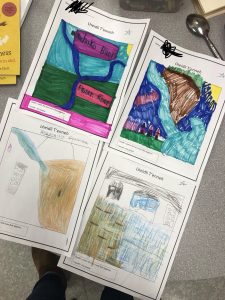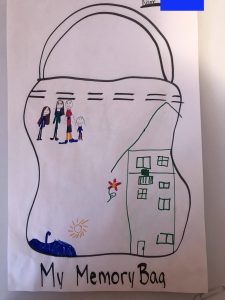
Students created drawings of the meaning of Lheidli T’enneh. Many students included the cutbacks and the colour of the rivers as well as buildings based on their personal experiences with both the Nechako and Fraser Rivers.
My one word for 2020 is local. I chose this word because it resonated with my teaching philosophy as well as in my personal life. My goal heading into my final practicum was to use local content in my teaching as much as possible in all subject areas. I think this was a very reasonable goal for myself and really will be something I focus on for much of my teaching career. Learning should take place in the local environment and be about the local environment as much as possible. I have seen firsthand how beneficial it is for student learning when they can relate to their learning and content on a personal level. For instance, students learned about beavers as part of science. I then brought up images of beaver dams and many students had connections to seeing beaver dams in and around Prince George. In another lesson we talked about the geography of Prince George and the Lheidli T’enneh people. Students learned about the history of the Lheidli T’enneh and the importance of both the Nechako and Fraser Rivers to the Lheidli T’enneh people. Students then drew a picture of the two rivers intersecting. The only criteria were that students had the two rivers intersecting on their picture, but most students also drew other landmarks that are unique to Prince George on their sheets that they used their own knowledge and experience with to draw. An example of this is that some students drew the cutbanks in their pictures, others coloured brown water as they noticed that was the colour of the river when they have seen it in person, and others included Lheidli T’enneh Memorial Park in their pictures. Students were so excited to share their pictures and the personal connections they made along the way when creating them. Learning in a local context gives meaning to student learning and ultimately helps with student engagement. Local knowledge is also important for every community member to learn.
Other examples of local content that I included in my lessons was doing a culture unit with my students in  Social Studies. This unit focused a lot on how each of us are unique, yet we may share some similarities with others in our classroom or in our greater community. Students participated in an activity where they created memory bags that remind them of home. Students were encouraged to think of what natural objects or things remind them of home. Some examples that students included in their memory bag that reminded them of home were trees and other plants and flowers that surround their house. One child drew the trails that surround his property where he goes walking and biking regularly. In science students participated in a sound walk where we listened to hear the different natural and artificial sounds in both our classroom, school, and outside of our school. After our sound walk, we talked about how the sounds we had written down are unique to being in a school and unique to where our school is located. An example of what we discussed is that the sounds in a school are different than what you might hear in an office building, such as a whistle blowing, or that the sounds outside of our school are unique to the area in which our school is situated in as we did not hear many cars since our school is on a quiet street. Students then talked about some of the sounds they might hear at their houses. This was something very cool to listen to as students that lived in a more rural environment identified different sounds from their houses than students who lived in a more populated area had identified.
Social Studies. This unit focused a lot on how each of us are unique, yet we may share some similarities with others in our classroom or in our greater community. Students participated in an activity where they created memory bags that remind them of home. Students were encouraged to think of what natural objects or things remind them of home. Some examples that students included in their memory bag that reminded them of home were trees and other plants and flowers that surround their house. One child drew the trails that surround his property where he goes walking and biking regularly. In science students participated in a sound walk where we listened to hear the different natural and artificial sounds in both our classroom, school, and outside of our school. After our sound walk, we talked about how the sounds we had written down are unique to being in a school and unique to where our school is located. An example of what we discussed is that the sounds in a school are different than what you might hear in an office building, such as a whistle blowing, or that the sounds outside of our school are unique to the area in which our school is situated in as we did not hear many cars since our school is on a quiet street. Students then talked about some of the sounds they might hear at their houses. This was something very cool to listen to as students that lived in a more rural environment identified different sounds from their houses than students who lived in a more populated area had identified.
 When I created my goal of including local content into my teaching, I was focused on Prince George specifically, but I also wanted to include content related to our broader local environment and chose to include some content that is unique to British Columbia. For an art/social studies lesson students were introduced to the Cherry Blossom Festival that happens in Vancouver in the Spring. Most students had never seen a cherry blossom tree before, so we looked up pictures of them and then talked about the cultural importance of the cherry blossom to Japanese people living in Vancouver. Students then created their own cherry blossom tree using paint, paper, and tissue paper to show texture. Students were very engaged when participating in this lesson and learning about the cherry blossoms and many were curious as to why cherry blossoms don’t grow in Prince George and how the cherry blossom trees came to be in Vancouver. This provided multiple learning opportunities and great discussion that went beyond Prince George yet did ultimately relate back to our local environment.
When I created my goal of including local content into my teaching, I was focused on Prince George specifically, but I also wanted to include content related to our broader local environment and chose to include some content that is unique to British Columbia. For an art/social studies lesson students were introduced to the Cherry Blossom Festival that happens in Vancouver in the Spring. Most students had never seen a cherry blossom tree before, so we looked up pictures of them and then talked about the cultural importance of the cherry blossom to Japanese people living in Vancouver. Students then created their own cherry blossom tree using paint, paper, and tissue paper to show texture. Students were very engaged when participating in this lesson and learning about the cherry blossoms and many were curious as to why cherry blossoms don’t grow in Prince George and how the cherry blossom trees came to be in Vancouver. This provided multiple learning opportunities and great discussion that went beyond Prince George yet did ultimately relate back to our local environment.
For the most part I believe I was successful with my #oneword2020 goal of including local content into my lessons. One of the challenges I did face when trying to include local content is that it can sometimes be difficult to find local resources. Most of my content came from my own research or knowledge of the local area. This was rather time consuming so it would have been better if more local resources were readily available for teachers in this school district. I know that from some of the professional development days that I have attended that are based on local content there is a push from community partners to create these resources for teachers to have better access to knowledge and history surrounding Prince George. I look forward to having these resources in the future not just for myself and other educators but also for community members to have access to as knowledge about local history is not something many Prince George residents have. Local is something that will guide my teaching for years to come and I am really looking forward to other ways I can include local content into my lessons by reaching out to community members and taking field trips to visit and explore the wonderful community that we live in.
Leave a Reply